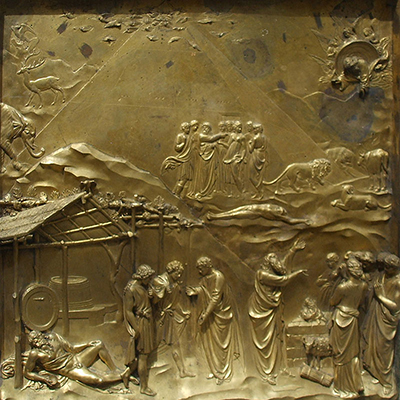Ghiberti continues his christian themes within the Gates of Paradise, as nicknamed by Michelangelo, with this multiple scene panel that concentrates on the life of Noah
The composition of multiple stories together in one panel is carried out by Lorenzo Ghiberti in his accompanying pieces too, such as with Adam and Eve and Cain and Abel. To achieve so much detail in bronze panels of around 79cm tall by 79cm wide seems unbelievable, underlining the magical qualities of this artist.
Noah lies beneath a wooden roof, presumably drunk, in the bottom left of the scene, the general theme of this piece is again the fall of mankind, mirroring the content of the Adam and Eve panel. The pyramid shape above represents the ark, with several creatures strolling around its outskirts, waiting to be allowed on for the great journey as told in Christian teachings.
The consistent format of these doors puts each composition in gilded bronze, leaving an uplifting finish, particularly when each of the panels are placed together. Bronze was expensive at this time, far more than the stone that most sculptors would have used, but Ghiberti was both a perfectionist and also a master at negotiation and understanding how respected he was by his donors. The completed doors would take 27 years to complete, even longer than his earlier north doors.
The impact of Lorenzo Ghiberti, through his bronze doors, was extraordinary. Sculpture was an enormous part of the early Renaissance and this master would bring about changes in perspective and the style of portraiture. There were, of course, a number of other highly influential Italian artists from the Renaissance, with several appearing right at its very inception. The likes of Masaccio and Giotto were early drivers in the changes in fresco painting, whilst Filippo Brunelleschi starred in architecture.




